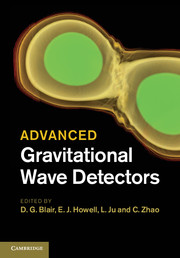Book contents
- Frontmatter
- Contents
- List of contributors
- Foreword
- Preface
- Introduction
- Part 1 An introduction to gravitational wave astronomy and detectors
- Part 2 Current laser interferometer detectors – three case studies
- 6 LIGO: The Laser Interferometer Gravitational-Wave Observatory
- 7 The Virgo detector
- 8 GEO 600
- Part 3 Technology for advanced gravitational wave detectors
- Part 4 Technology for third generation gravitational wave detectors
- Index
7 - The Virgo detector
from Part 2 - Current laser interferometer detectors – three case studies
Published online by Cambridge University Press: 05 March 2012
- Frontmatter
- Contents
- List of contributors
- Foreword
- Preface
- Introduction
- Part 1 An introduction to gravitational wave astronomy and detectors
- Part 2 Current laser interferometer detectors – three case studies
- 6 LIGO: The Laser Interferometer Gravitational-Wave Observatory
- 7 The Virgo detector
- 8 GEO 600
- Part 3 Technology for advanced gravitational wave detectors
- Part 4 Technology for third generation gravitational wave detectors
- Index
Summary
This chapter describes the Virgo interferometric gravitational wave detector. We first discuss the overall detector design before describing the individual subsystems in detail. We finish by outlining the commissioning and upgrades required to achieve second generation sensitivity.
Introduction
The gravitational wave detector Virgo1, funded by CNRS (France) and INFN (Italy), is a recycled Michelson interferometer with arms replaced by 3 km long Fabry–Perot cavities. Virgo is located at the European Gravitational Observatory (EGO), close to Cascina (Pisa, Italy), and is the only ground-based antenna which, from its conception, aimed at reducing the detection band lower threshold down to 10 Hz. This goal was achieved by isolating the interferometer mirrors from ground seismic noise which, in the tens of hertz range, is many orders of magnitude larger than the small variation of the arm length induced by the gravitational wave passage.
The construction of Virgo started in the second half of 1990s and, after a commissioning phase of several years, the interferometer performed two scientific runs (VSR1, lasting four months in 2007, and VSR2, from July 2009 to January 2010), in coincidence with the antennae of the LIGO project.
Once the antenna is isolated from ground seismic noise, thermal displacements induced by pendulum dissipations in the mirror suspensions (pendulum thermal noise) limit the sensitivity up to a few tens of hertz. At higher frequency, the thermal noise induced by dissipation inside the mirror (mirror thermal noise) is dominant, up to a few hundreds of hertz. Above this frequency, the antenna sensitivity is mainly suppressed by the shot noise in the photo detection.
Information
- Type
- Chapter
- Information
- Advanced Gravitational Wave Detectors , pp. 133 - 154Publisher: Cambridge University PressPrint publication year: 2012
